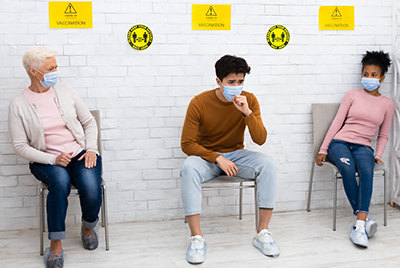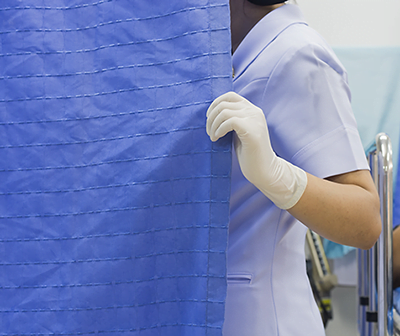Hidden Dangers
Medical facilities should be clean and hygienic. In the healthcare industry, where the well-being and lives of patients are at stake, the importance of cleanliness extends far beyond mere aesthetics. Clean medical facilities play a vital role in preventing the spread of infections, maintaining patient safety, instilling confidence in the healthcare system, and ensuring the overall delivery of high-quality healthcare services. However, there are several surprisingly dirty surfaces in medical facilities that might surprise you.
Waiting Room Chairs
 Medical facility waiting rooms are often crowded with patients and their families, all sharing the same seating areas. While waiting for their turn, patients may cough, sneeze, or touch their faces, leaving behind germs on the armrests and seats of chairs. The risk of infection comes not only directly from infected patients, but also from chairs, leaflets, and other reading materials that may have been touched or expectorated upon. Regular cleaning of waiting room furniture is essential to prevent the spread of infections.
Medical facility waiting rooms are often crowded with patients and their families, all sharing the same seating areas. While waiting for their turn, patients may cough, sneeze, or touch their faces, leaving behind germs on the armrests and seats of chairs. The risk of infection comes not only directly from infected patients, but also from chairs, leaflets, and other reading materials that may have been touched or expectorated upon. Regular cleaning of waiting room furniture is essential to prevent the spread of infections.
Doorknobs and Handles
High-traffic areas in medical facilities are equipped with doorknobs and handles. These surfaces are frequently touched by individuals who may not have clean hands. Proper cleaning and disinfection of doorknobs and handles can help reduce the risk of infections spreading within the facility.
Elevator Buttons
 One of the most commonly touched surfaces are elevator buttons. Patients, visitors, and healthcare workers frequently use elevators to move between floors. Unfortunately, elevator buttons can be a breeding ground for germs and bacteria. Many people touch these buttons without washing their hands, making them a hotspot for potential cross-contamination.
One of the most commonly touched surfaces are elevator buttons. Patients, visitors, and healthcare workers frequently use elevators to move between floors. Unfortunately, elevator buttons can be a breeding ground for germs and bacteria. Many people touch these buttons without washing their hands, making them a hotspot for potential cross-contamination.
Privacy Curtains
 Privacy curtains are often neglected although they get contaminated fast. One study found that 42% of hospital privacy curtains were contaminated with vancomycin-resistant enterococci (VRE). It takes only 2 weeks for curtains to become infected with MRSA, C.Diff, VRE and other deadly bacteria/viruses. In some places, they can hang for a year without being cleaned or replaced.
Privacy curtains are often neglected although they get contaminated fast. One study found that 42% of hospital privacy curtains were contaminated with vancomycin-resistant enterococci (VRE). It takes only 2 weeks for curtains to become infected with MRSA, C.Diff, VRE and other deadly bacteria/viruses. In some places, they can hang for a year without being cleaned or replaced.
Computer Keyboards, Mice & Mobile Phones
Medical staff rely heavily on computers for patient records and information. Numerous individuals touch keyboards and mice throughout the day. These surfaces can become breeding grounds for bacteria, including potentially harmful pathogens. Mobile phones can harbor germs and bacteria, and healthcare workers may inadvertently spread these pathogens to patients. One study found that 90% of healthcare workers never clean their mobile phones. Regular disinfection of these devices is crucial to maintaining a safe environment.
Stethoscopes
 Stethoscopes are essential tools for healthcare professionals, used in patient examinations. Unfortunately, stethoscope diaphragms and tubing can harbor harmful bacteria and pathogens. Healthcare providers must make it a habit to clean their stethoscopes between patients to prevent cross-contamination.
Stethoscopes are essential tools for healthcare professionals, used in patient examinations. Unfortunately, stethoscope diaphragms and tubing can harbor harmful bacteria and pathogens. Healthcare providers must make it a habit to clean their stethoscopes between patients to prevent cross-contamination.
Reasons Behind Contamination
- High Foot Traffic: The constant flow of people in and out of medical facilities increases the likelihood of surface contamination.
- Inadequate Cleaning Practices: In some cases, there may be insufficient cleaning and disinfection routines in place, allowing pathogens to thrive.
- Lack of Hand Hygiene: Not everyone entering a medical facility follows proper hand hygiene protocols so this leads to the spread of germs when they touch surfaces. Studies show that 20-40% of hospital infections result from hand cross-infection by healthcare workers
- Shared Spaces: Waiting rooms and shared amenities provide opportunities for germs to transfer from one person to another.
Importance of Cleanliness in Healthcare Settings
- Infection Control: Clean environments reduce the risk of healthcare-associated infections, which can be life-threatening.
- Patient Safety: Ensuring that all surfaces are clean and free from pathogens is essential for patient safety and well-being.
- Staff Health: Exposure to contaminated surfaces puts healthcare workers at risk.
- Reputation: A clean and hygienic environment enhances the reputation of a medical facility and instills trust in patients and visitors.
In conclusion, while we expect medical facilities to prioritize cleanliness and hygiene, it’s essential to recognize that even seemingly innocuous surfaces can harbor hidden dangers. The widespread use of these surfaces by patients, visitors, and healthcare providers underscores the need for regular cleaning and disinfection protocols. Facility managers should consider hiring an OSHA-trained cleaning company. This will ensure daily proper cleaning and disinfection. By maintaining a clean environment and promoting good hand hygiene, medical facilities can contribute to better patient outcomes and overall safety. Awareness and diligence are key to mitigating the risks associated with surprisingly dirty surfaces in healthcare settings.